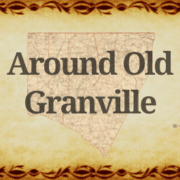TownTalk: Around Old Granville – First Families Part Two
Ready to hear how the area now known as Kittrell is connected to the first Thanksgiving?
THE first Thanksgiving.
The one that happened in 1618, a full four years before the Pilgrims and Native Americans celebrated the first successful harvest in Plymouth, Massachusetts in 1621.
Leave it to WIZS’s Bill Harris and local historian Mark Pace to make the local connection in their tri-weekly TownTalk segment called Around Old Granville. Monday’s discussion was a continuation of “First Families” of the area that now includes the four counties of Vance, Granville, Warren and Franklin.
According to Pace, a man by the name of John Woodlief gets the credit for the very first Thanksgiving that took place at Berkeley Plantation on the banks of the James River southeast of Richmond. It is Woodlief’s grandson, Thomas Woodlief, who leaves Charles City, VA and settles in the vicinity of what is now Kittrell way back in 1754, when the Colonies were still under British rule.
Woodlief is just one of numerous notable surnames that pop up in research of local history, but sometimes genealogists and historians have to do a bit of detective work to find useful tidbits about people who lived and worked in the area almost three centuries ago.
Kittrell is another family name that predates the birth of the United States. The earliest Kittrells came pretty early, Pace said, back in 1727. Then Jonathan Kittrell purchased 300 acres or so in the area along Tabbs Creek around 1760.
Another well-known family was the Eaton family. “The Eatons would definitely qualify as one of the first founding families of this area,” Pace said.
William Eaton first settled up in the northeast corner of the old Granville County along the Roanoke River – a ferry bearing the family name operated from the 1800’s to the early 1960’s near Littleton in Warren County.
Eaton also built the first courthouse and the first jail – with his own money – in Granville County
and he built Locust Hill on Old County Home Road in Vance County.
“It was actually THE county home” at one time, Pace noted. Eaton died in 1759 and his children were influential in the area for the next hundred years or more, up until the Civil War.
Locust Hill burned in 1976. Pace remembers the year vividly because it was the year he got his driver license. He and his younger brother tootled out to Locust Hill and the brother snapped a pic of the old home with his Polaroid.
“About two weeks later, it burned down…my brother took the last picture of it,” Pace said. He said the back portion of the home could easily date back to the 1740’s – “It wouldn’t surprise me,” Pace said.
One son, Thomas Eaton, was a general in the American Revolution. He was captured during the Battle of Brier Creek in Georgia, and legend has it that when he was captured, the British sympathizers confiscated his prized boots, made specially to fit his quite narrow foot. Fast forward to a post-war “sit down” Eaton was summoned, along with one of his captors, who returned the long-lost boots to Eaton.
And although Pace said he can’t confirm what happened, the story goes that Eaton proceeded to whack the captor over the head with said boots. So much for letting bygones be bygones.
There’s a stately home in Warrenton – the William Eaton home – that still stands today that belonged to a son of Thomas Eaton.
William Eaton, an attorney and prominent politician, wrote a book called “How to be a Good Lawyer” which Pace said was a bestseller in the 1830’s and 1840’s.
The Eatons have a connection with Osborne Jeffreys, who was born in Williamsburg, VA in 1716.
Jeffreys was a captain in the North Carolina Colonial militia for Granville County, said Harris, and owned several plantations in the area, which included grist mills, a tannery, a shoe-making business and taverns. Jeffreys also was active in the politics of the area. Like many early settlers, Pace said Jeffreys “owns land all over the place…he comes here (early) and gets the best land” for himself. He built Portridge on some of his land holdings, which was located between what is now Louisburg and Franklinton. It was at Portridge that the first church of England was built in the area. The building is long gone, but the cemetery remains. It contains many unmarked graves, but the names on some stones are legible.
Jeffreys and his wife, Patience, had a daughter named Elizabeth. She married Charles Rust Eaton, another descendant of the original William Eaton.
A dozen or so families in Colonial North Carolina, he said, intermarry and create what Pace calls an oligarchy – “they’re the ones who run things,” he explained.
Listen to the entire discussion at wizs.com.
CLICK PLAY!

